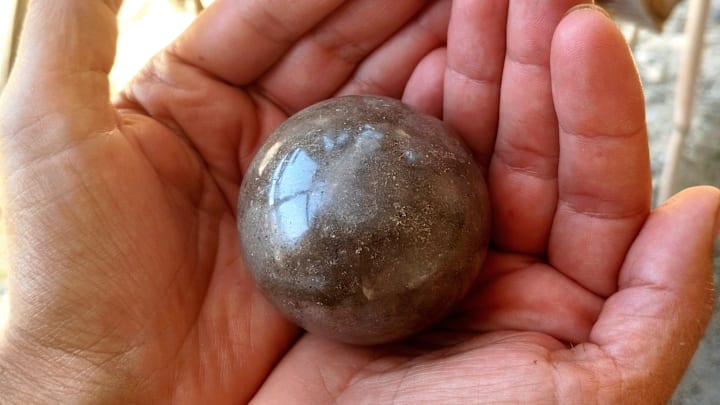The Japanese art of hikaru dorodango has made its way from humble nursery school playgrounds to the studios of artists worldwide. The term roughly translates to “shining mud dumpling,” which is a pretty apt descriptor of the final product; it’s quite literally a hardened ball of mud that’s polished until it shines. Though they take some time and effort, making one at home is surprisingly simple.
- The Playground Origins of Hikaru Dorodango
- Hikaru Dorodango as an Artform
- How to Make a Dorodango at Home
The Playground Origins of Hikaru Dorodango
No one is quite sure how hikaru dorodango originated, but it’s clear that it wouldn’t be as prominent as it is today without the efforts of Japanese developmental psychology professor Fumio Kayo. In 1999, Kayo was visiting a Kyoto nursery school to observe children at play when he noticed them deeply concentrated on forming playground dirt into shining spheres. It was a painstaking process even teachers would join in on. After working so long and so hard to create them, the dorodango would become treasured possessions of the children.

Making a dorodango involved locating the perfect soil, mixing it into mud, molding it into a sphere, and finally polishing it to perfection. The art requires patience, trial and error, and resourcefulness, causing it to be praised for its beneficial impact on early childhood development. Indeed, Kayo both published academic papers on the subject as well as developed a simple methodology that allowed him to introduce the activity to children across Kyoto. Hikaru dorodango was featured by Japanese public broadcaster NHK in 2001, and it has slowly gained prominence internationally—and among adults—since then.
You Might Also Like:
- Amezaiku: The Nearly Lost Japanese Art of Candy Sculpture
- Watching Blobs of Paint Move to Chopin Is Oddly Soothing
- 20 Boredom-Busting Science Experiments You Can Do at Home
Hikaru Dorodango as an Artform
The finished dorodango is enchanting. If created properly, the ball should be spherical and wonderfully glossy. Science fiction writer and essayist William Gibson was so enamored with them that he called them “artifact[s] of such utter simplicity and perfection that it seems [they] must be either the first object or the last...”
Other artists around the world have also found creating the mud balls to be both an excellent creative outlet as well as a grounding meditative practice. Artist Kiyoko Miki, for instance, uses different soil types and paint to create colored pastes, turning her dorodango into every color of the rainbow. She even drills holes into some to make charming flower vases.

Albuquerque-based dorodango artist Bruce Gardner not only makes incredibly varied mud balls with local soils from all over New Mexico, but hosts online workshops teaching hikaru dorodango to others spanning the globe. Students from Afghanistan to New Zealand have tuned in to learn from one of the most prominent dorodango artists in the western world.
“It’s almost a necessity for me,” Gardner said of the practice in one interview. “It’s my meditation.”
Below, find Gardner’s instructions for creating the perfect dorodango. All you need is a sifter, water, a soft cloth, a little dirt, and a lot of patience.
How to Make a Dorodango at Home
First, you want to create your mud. Slowly mix sifted dirt with water until the mud has an even, dough-like consistency.
Then, slowly start to work the mud into a sphere shape while squeezing out as much water as possible. Gently shake the sphere as you shape it with your hands. As you continue to mold it, particles will rise to the surface, making it easier to smooth the sphere out.
Once the ball feels tacky, grab handfuls of dirt and sprinkle them all over the ball. Use the outside part of the base of your thumb to gently sweep off any excess. Continue working the ball into shape until it feels solid, but avoid letting it get so dry that cracks emerge.
Run a hand through more dry, sifted dirt. Rub the particles that stuck to your hands onto the mud ball and repeat until the surface of it feels oily and/or more dirt stops sticking to it.
Finally, polish the mud ball with a soft cloth. If the mud ball is at all wet, go very carefully to avoid messing up the shape. Once the ball is completely dry, you can polish it with more energy. You can even compress the ball with a glass bowl to create a shinier surface, if desired.
It may take several tries to achieve a dorodango that doesn’t look like ... well, just a messy mud ball. But part of the point of hikaru dorodango is learning to enjoy the contemplative process—and hopefully, reconnect with your inner child at the same time.
Read More About Arts and Crafts:
